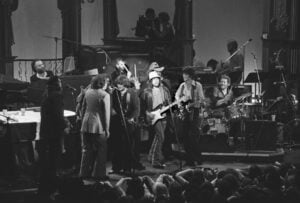10 Recording Errors That Made It into Famous Rock Tracks

via Ofir Kariv / YouTube
Recording rock music is a complex process, but even the most polished productions sometimes include mistakes. Instead of removing these errors, artists occasionally let them stay, turning accidents into memorable moments. Here are ten famous rock tracks where recording errors became part of the final mix.
1. The Rolling Stones – “Sympathy for the Devil”
During the recording of “Sympathy for the Devil,” a mistake led to a sudden shift in the song’s rhythm. Originally, the track had a folk-like tempo, but a miscue during a session caused the band to experiment with a samba beat. The unplanned change gave the song its iconic groove.
The lively rhythm complemented Mick Jagger’s lyrics, creating a dynamic atmosphere. Producer Jimmy Miller decided to keep the samba style, recognizing how the error added energy to the track. The unexpected shift became one of the song’s defining features.
2. The Beatles – “Hey Jude”
Near the end of “Hey Jude,” Paul McCartney accidentally sings the phrase “f***ing hell” after hitting a wrong note. The expletive was not removed from the final mix, though it’s buried in the background and hard to notice without careful listening.
Rather than causing controversy, the slip added a raw, unfiltered quality to the recording. Fans later discovered it and celebrated the imperfection as a glimpse of the band’s human side, proving that even The Beatles weren’t immune to studio mishaps.
3. Led Zeppelin – “Since I’ve Been Loving You”
In this bluesy track, a squeaky kick drum pedal can be heard throughout the song. Despite the intrusive sound, Led Zeppelin decided not to fix it, leaving the unintended noise in the final mix.
The squeak became a quirky detail that fans often point out. It’s a reminder of the raw, unpolished energy that defined much of Led Zeppelin’s music. The band’s choice to keep the imperfection highlights their commitment to authenticity.
4. Pink Floyd – “Wish You Were Here”
At the start of “Wish You Were Here,” you can hear coughing and some rustling noises. These sounds came from band members as they prepared to record, but they weren’t edited out of the final track.
The ambient noise added a sense of intimacy to the song, making listeners feel as though they were in the studio with the band. This unintentional inclusion fits the track’s reflective and personal tone, enhancing its emotional depth.
5. Nirvana – “Polly”
In “Polly,” a faint laugh can be heard in the background during one section of the song. This occurred when Kurt Cobain reacted to a small mistake but continued playing. Instead of re-recording, the band left it in.
The subtle laugh adds to the raw, stripped-down nature of the track. It reflects Nirvana’s ethos of embracing imperfections, a theme that runs through much of their music and resonated deeply with their fans.
6. David Bowie – “Heroes”
The vocal track in “Heroes” includes audible bleeding from other recordings in the studio. This was due to the use of multiple microphones capturing Bowie’s performance at varying distances, creating a layered and echoing effect.
The technical error gave the song a haunting, atmospheric quality. Producer Tony Visconti embraced the flaw, turning it into an innovative feature that contributed to the track’s iconic sound.
7. The Police – “Roxanne”
At the beginning of “Roxanne,” Sting accidentally leaned on a piano, producing an off-key note and laughing about it. Both the note and the laugh were left in the final version of the song.
The brief moment of humor adds a playful charm to the track. It’s a small but memorable detail that fans have come to appreciate, showing that not every recording needs to be flawless.
8. Bruce Springsteen – “Born to Run”
During the recording of “Born to Run,” the glockenspiel part features some timing errors. Instead of re-recording, Springsteen decided to leave the imperfections in, feeling they added character to the song.
The minor mistakes became part of the track’s larger-than-life sound. They highlight the ambitious scope of the recording process and the emotional intensity that defines the song.
9. Queen – “Bohemian Rhapsody”
In “Bohemian Rhapsody,” faint background chatter can be heard during quieter sections. These noises came from band members talking in the studio and were not fully removed during editing.
The chatter adds a subtle layer of texture to the track. While unintentional, it underscores the collaborative energy that went into creating one of rock’s most intricate and beloved songs.
10. Bob Dylan – “Rainy Day Women #12 & 35”
Laughter and shouting are audible throughout “Rainy Day Women #12 & 35.” These sounds came from Dylan and the session musicians joking around during the recording. Instead of cleaning up the track, Dylan kept the spontaneous moments.
The unfiltered noise perfectly matches the song’s laid-back, celebratory vibe. It’s a prime example of how embracing imperfections can enhance the authenticity of a recording.























